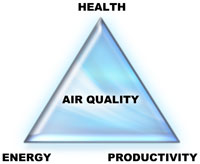Combustion by-products
Combustion generates H2O, NO, NO2, CO, CO2 and particulate. Combustion can also emit hydrocarbon gases, vapours, and organic particles. Impurities such as metals, mercaptans, sulphur oxides and other particles can be emitted. Some of the particles are large and settle out, but the majority of the particles are submicron and remain suspended in the air for long periods of time
Burning of gas heaters produces NO2 and CO which must be vented to the outdoors. Space heaters emit particles, CO, NO2, and sometimes SO2. Gas stoves emit particles as well as gases. Wood and coal stoves emit particles when the stove is open for loading. Fireplaces emit particles constantly.
Internal combustion engines can be a source of indoor air pollution in offices, schools, hospitals, hotels, shopping centres and stores especially where garages are attached. In large cities with high number of vehicles present the ambient air is normally containing a high number of particles and gases. Efficient particle filtration of submicron and ultrafine particles as well as molecular filtration of the supply air can reduce this contamination significantly.
